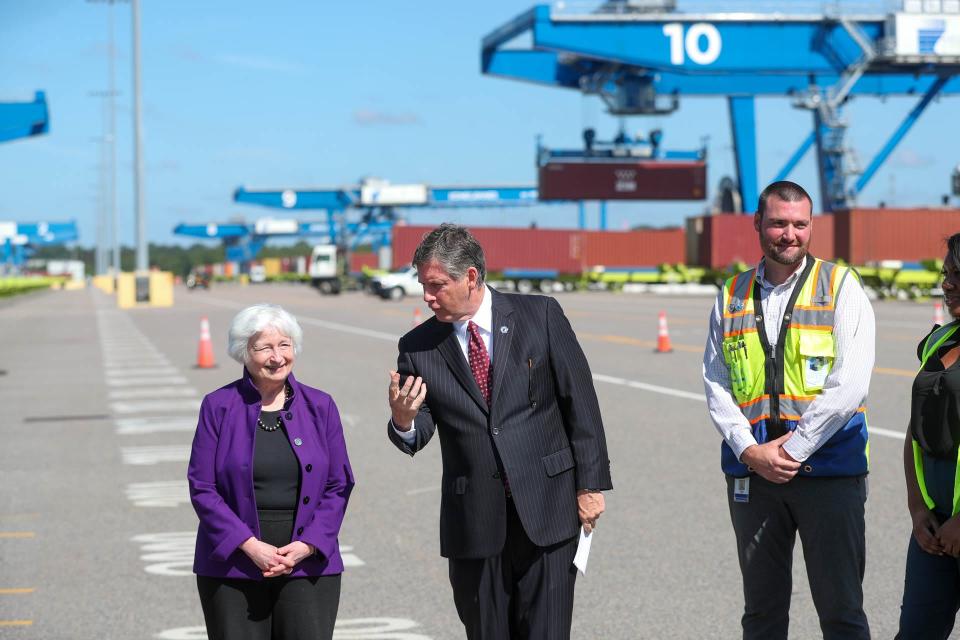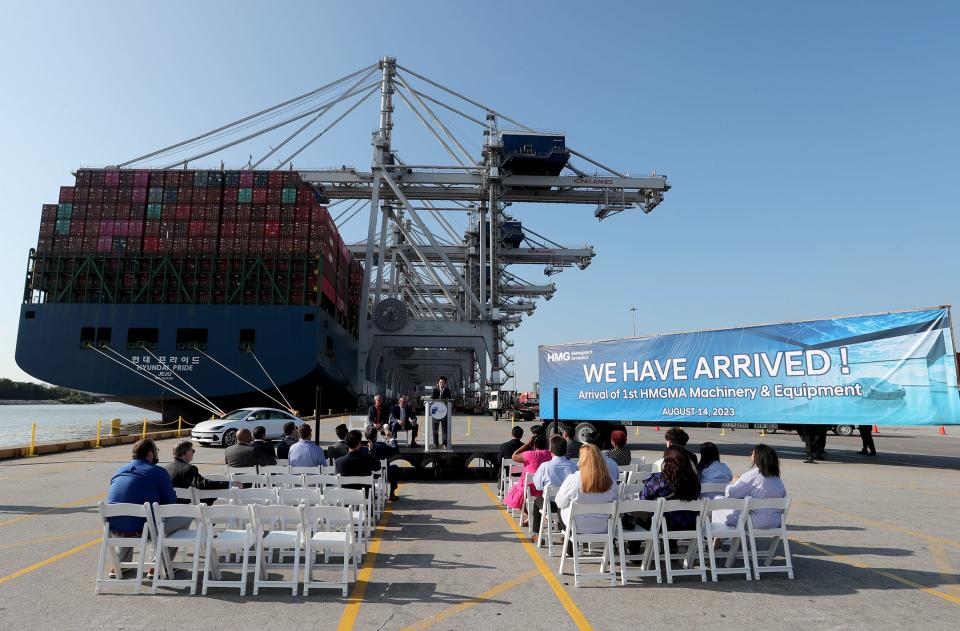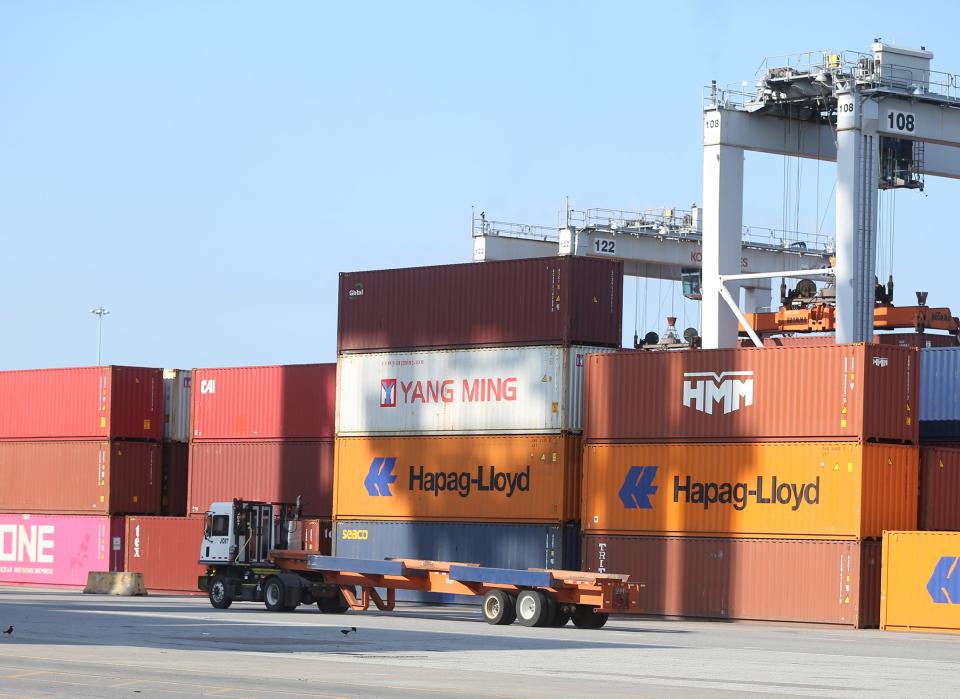Georgia Ports seeks study on deepening the Savannah River again
This article appears as part of a cooperative agreement between the Atlanta Journal-Constitution and the Savannah Morning News.
SAVANNAH ― Just 18 months after crews finished the $1 billion dredging of the Savannah River channel, the Georgia Ports Authority wants to study deepening the shipping lane again.
Lauded as one of Georgia’s largest economic development projects, the last deepening helped Savannah become one of the busiest ports in North America. Now, officials say, to remain competitive, a new round of deepening is needed amid a massive shift in international trade routes between the U.S. East Coast and Asian manufacturing hubs.
“By the time we completed the last deepening, we were again behind the times,” Georgia Ports Authority CEO Griff Lynch said.
Georgia’s ports are huge economic drivers. The Port of Savannah and other ports authority facilities support 561,000 jobs and contribute $59 billion annually to the state’s gross domestic product, a recent study showed. The ports’ business has nearly doubled over the last decade, and officials have announced expansion projects that will significantly boost container capacity by 2030.
The latest dig dropped the river bottom to 47 feet, deep enough to handle the biggest ships that cross the Pacific Ocean and transit the expanded Panama Canal en route to Savannah and other East Coast ports.
But growth in manufacturing in Asian nations outside China — including India, Thailand and Vietnam — has shippers sending more goods west on bigger vessels from Asia through Egypt’s Suez Canal and across the Atlantic Ocean. These ships require deeper and wider channels to access ports.
Another deepening in Savannah is likely to take years, require bipartisan political support in a fractured Congress and could involve hundreds of millions of state funds, just as the last one did.
The most recent expansion wrapped in March 2022, more than 25 years after the U.S. Army Corps of Engineers conducted a similar deepening study. Port authority officials say a new effort will also require widening the river channel at strategic points and would take approximately a decade.
A new round of dredging is likely to face fierce opposition from environmental advocates. The most recent project required hundreds of millions of dollars spent to preserve or build new wetlands and to protect wildlife.
Ports authority officials have already requested authorization from Congress to seek a study. Georgia’s Democratic U.S. Sens., Raphael Warnock and Jon Ossoff, and U.S. Rep. Buddy Carter, a Republican who represents coastal Georgia, have voiced their support.
The ports authority’s Lynch is expected to highlight the need for enlarging the harbor during Thursday’s annual Savannah State of the Ports luncheon. The changes are part of broader expansion plans that include elevating the roadway of the Talmadge suspension bridge over the Savannah River and construction of a third container terminal.
“The East Coast is in a good position to add market share,” Lynch said. “The question for us is: Will we be in the best position to be competitive?”
Georgia Ports: U.S. treasury secretary visits Savannah; dubs port the most impressive she has visited
Workforce Housing: Georgia Ports to invest $6 million in new housing initiative. How will those funds be used?

Why wasn’t the last dredging deeper?
Engineers based the last Savannah River deepening on the then-planned expansion of the Panama Canal.
The canal’s locks system limits the width of ships. Vessels built to carry more than the equivalent of 15,000 20-foot-long cargo containers can’t transit the canal.
The last dredging met the minimum depth required for fully loaded “post-Panamax” ships to reach Savannah at all tides. The original target was 48 feet, but concerns about wetlands damage and impacts on the Floridan Aquifer, the main source of drinking water for 10 million Americans, led to a scaleback.
Concerns about the aquifer will likely be one of the hurdles supporters of deepening will have to overcome. Anticipating such pushback, Lynch vowed the ports authority would not advocate for “anything that impacts the aquifer.”
Bigger ships, known as “Suezmax” vessels, carry up to 9,000 more containers than the Panama Canal freighters. They need at least 50 feet of depth below the waterline when fully loaded with cargo.

Why trade is shifting to bigger ships?
Nearly a quarter of all container ships on order or under construction today are for Suezmax vessels, according to February report from shipping consulting firm Alphaliner. The trend is due in part to the emergence of India, Thailand and Vietnam as manufacturing rivals to China.
Companies have diversified their factory locations over the last five years, adopting what Savannah-based maritime trade consultant Walter Kemmsies calls a “China plus one” strategy. Driven by the tariff war launched by then-President Donald Trump against China in 2018 and exacerbated by China’sadversarial stances against the U.S., the manufacturingmovement to west Asia is accelerating.
Ships departing from those ports can reach U.S. East Coast ports via the Suez as quickly as they can by heading across the Pacific and through the Panama Canal. The wider Suez allows the bigger ships, creating economies of scale for shippers.
Cargo in Savannah can reach Southeast and Midwest destinations within two days of being unloaded. And the state-run entity has not suffered the labor disruptions that have plagued other U.S. ports.

What would another deepening involve?
Another round of dredging would not only deepen the channel but widen the lane as well.
The Port of Savannah sits 22 miles from the river’s mouth, and the inland stretch is not straight. Vessels often must stop and wait for another ship to clear these narrow sections before preceding.
Suezmax ships measure 1,300-feet long and 24 containers wide and would create more of a logjam.
The channel study would focus on ways to address these tight corners, Lynch said.
What’s next?
Study authorization would come as part of a renewal of the Water Resources and Development Act (WRDA) next year. Up for reauthorization every two years, the WRDA enables the Corps of Engineers to take action on a specific list of projects meant to improve rivers, harbors and other bodies of water. WRDA authorization does not include funding for those initiatives.
Georgia lawmakers lobby for the inclusion of state projects in the WRDA.
Adam Van Brimmer is a journalist who covers politics and Coastal Georgia news for The Atlanta Journal-Constitution.
This article originally appeared on Savannah Morning News: Georgia Ports seeks study on deepening the Savannah River again

